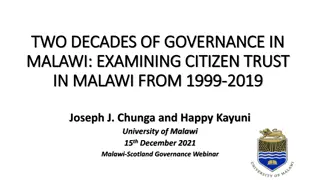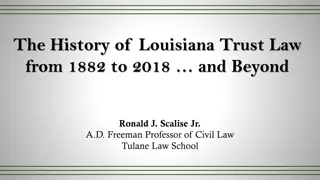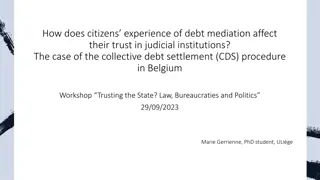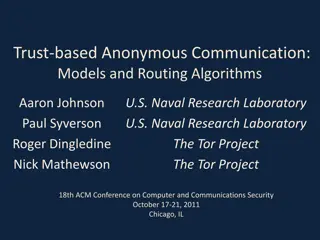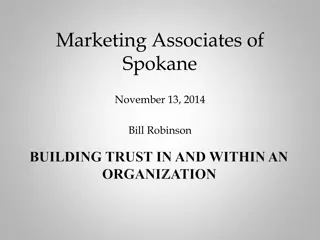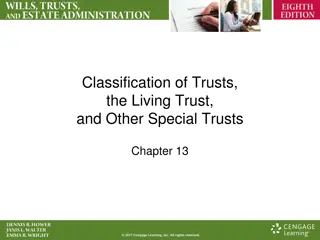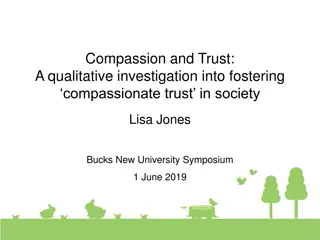
Understanding Trust, Contract, and Bailment in Law
Explore the differences between trust, contract, and bailment in law. Learn how each concept operates, their legal implications, and key distinctions such as the doctrine of privity of contract. Delve into the nuances of creating trust-like arrangements within contracts and the legal principles governing bailment transactions.
Download Presentation

Please find below an Image/Link to download the presentation.
The content on the website is provided AS IS for your information and personal use only. It may not be sold, licensed, or shared on other websites without obtaining consent from the author. If you encounter any issues during the download, it is possible that the publisher has removed the file from their server.
You are allowed to download the files provided on this website for personal or commercial use, subject to the condition that they are used lawfully. All files are the property of their respective owners.
The content on the website is provided AS IS for your information and personal use only. It may not be sold, licensed, or shared on other websites without obtaining consent from the author.
E N D
Presentation Transcript
In law these are two completely different things. A trust is a dedicated fund created for the benefit of a designated recipient. A contract is a legally binding agreement between two individuals or entities, in which each exchanges promises to give something of value to the other.
The contract is similar to the trust in the sense that both are written agreements and both can be used to mange property of others. The contract is so flexible that it can be used in nearly all branches of law. However, despites all these similarities, it should be noted that in a contract it is essential to have consent of the contracting parties, whereas in the trust concept, consent is not a determining condition. This is because trusts can be created by law. A trust be also be created by a perfectly unilateral act.
The doctrine of privity of contract: The doctrine of privity was accepted into English Law in Price v. Easton (1833) 4 b & Ad 433) and the House of Lords has provided a more modern authority for the doctrine in Dunlop Pneumatic Tyre Co. Ltd. v. Selfridge & Co. Ltd. [1915] AC 847 case.
This is a common law principle which provides that a contract cannot confer rights or impose obligations upon any person who is not a party to the contract. The premise is that only parties to contracts should be able to sue to enforce their rights or claim damages as such.
Distinctions: 1. Contracts can create trust-like arrangements but in most cases they will be unenforceable by the third party (who was intended to receive a benefit) under the doctrine of privity of contract.
Bailment: Bailment is a transfer of custody of a piece of property rather than a transfer of ownership of a piece of property. Bailment is a legal relationship in common law, where the owner transfers physical possession of personal property ("chattel") for a time, but retains ownership. ... The bailee holds the personal property in trust for a specific purpose and delivers the property back to the bailor when the purpose is accomplished.
When we entrust our property or assets to others, we are often putting those things in bailment. In this sense, the concept is similar to that of fiduciary duty. In both cases, someone is being entrusted with others' assets and must act to protect those assets while in their custody.
Bailment happens every day: at the bank, when we put things in a safe deposit box, at a restaurant when we give the car to the valet, and at the dry cleaners when we leave a dress to be cleaned. The person managing your stock portfolio, and the person managing your rental property also are bailees in a sense.
For example, let's say John Doe owns a big piece of farmland on the eastern shore of Maryland. His adult son wants to move to the area and farm the land. Rather than transferring ownership of the property to his son, John Doe (bailor) transfers possession or custody of the farmland to his son (the bailee).
The son might pay rent or a lease fee in return. The son only receives custody and control of the property, but John still owns it. John is thus responsible for paying the property taxes and is liable for what happens on the land (unless the bailee failed to care for the land properly).
In general, there are three kinds of bailments: Service agreement bailments, whereby the bailee agrees to perform a service for the bailor (such as park or store a car). Constructive bailment, whereby the bailee agrees to protect the bailor's asset (such as with a safe deposit box). Gratuitous bailments, whereby the bailor doesn't receive payment from the bailee for the bailment (such as in free coat checks at a restaurant).
Distinctions: The distinction between trust & bailment is well evidenced in the dealings that a trustee & bailee may have with third parties. A trustee may pass the property on to an innocent third party purchaser. A bailee cannot pass any proprietary title on because a bailee only holds a possessary title. Furthermore, a bailment can only arise with respect to personal property, whereas a trust can be created over real or personal property.
1. A trustee becomes the owner of the trust property whereas the bailee does not become the owner of the bailed property 2. The obligation of bailee is legal, whereas that of a trustee is equitable 3. A bailment may be only in respect of movable property whereas trust can be created both the respect of movable property as well as immovable property 4. Only personal chattels can be bailed, while property may be held in trust
Agency Trust Whereas title to property under a trust must be vested in a trustee. A trust only exists if it holds property. An agency relationship can be created without vesting any property in the agent, The agent himself does not have to be party to contracts. A trust is always the result of a contract with a grantor. A trustee who makes a contract in the administration of the trusts contracts as if he was the principal. The agent is not the principal. Whereas an agent creates a contract on behalf of the principal, he himself is not a party to the contract with another party. A trustee opens accounts as principal of the account which holds property under conditions of the indenture of the trust. At common law the relationship of principal and agent terminates on the death of either. If a trustee dies, however, the trust is not terminated. Instead, a new trustee is appointed.
A debt is an obligation that must be repaid such as a loan or a credit card. A trust means an account that holds money that belongs to another. So, if you don t pay your credit card bill or mortgage, you may be sued or have your home sold, but if you steal from a trust, you are going to be imprisoned.
Where a loan has been made the borrower becomes the absolute owner of the money lent, subject to a contractual obligation to repay the loan or to perform some other obligation specified in the loan agreement. The borrower is free to spend the money however they like even if the parties assume that the loan will be used for a specific purpose. In the event of the debtor s bankruptcy the lender is an unsecured creditor, entitled only to share rateably with the debtor s other creditors such of the debtor s assets as are available for distribution among the unsecured creditors.
When a trust has been created, the trustee holds only legal title to the trust property, the equitable title being held by the beneficiary. The trustee is not free to spend the money as they wish but must keep it separate from their own money and apply it only for the purposes of the trust. In the event of the trustee s bankruptcy the money will not be divisible under among the trustee s creditors but will continue to be held on trust for the beneficiary.



